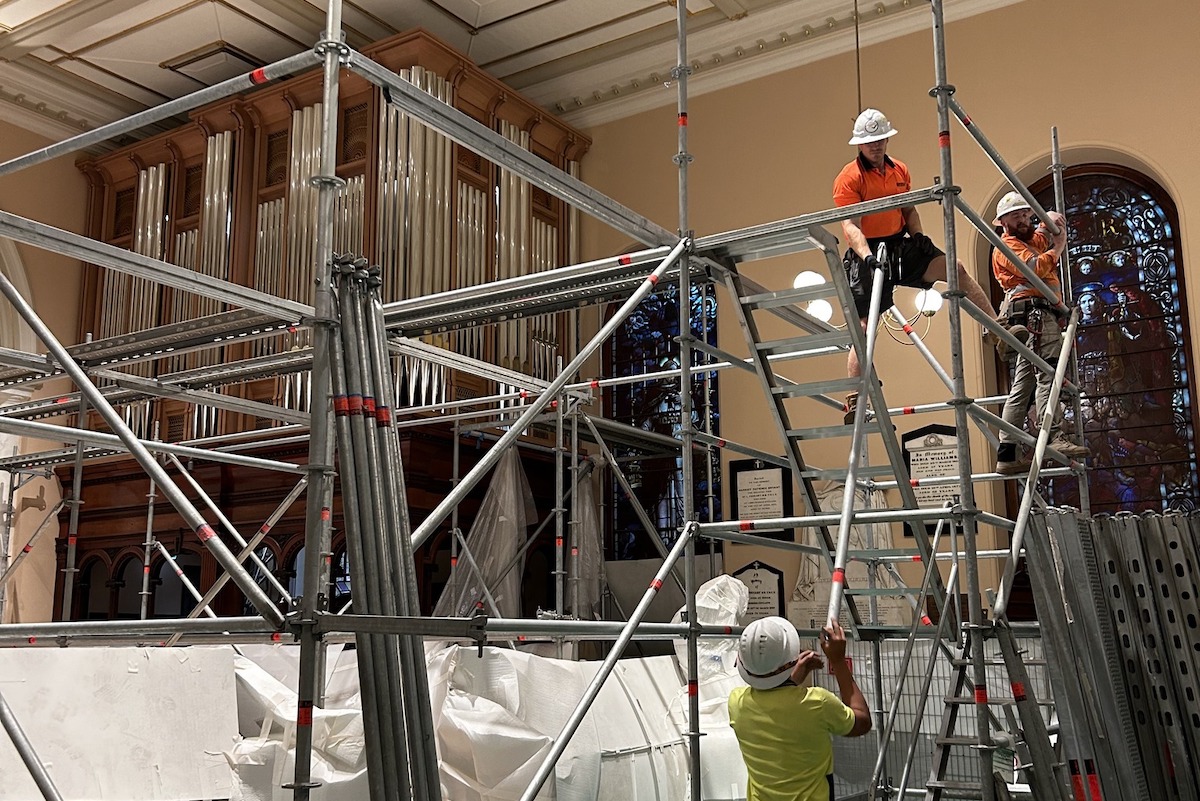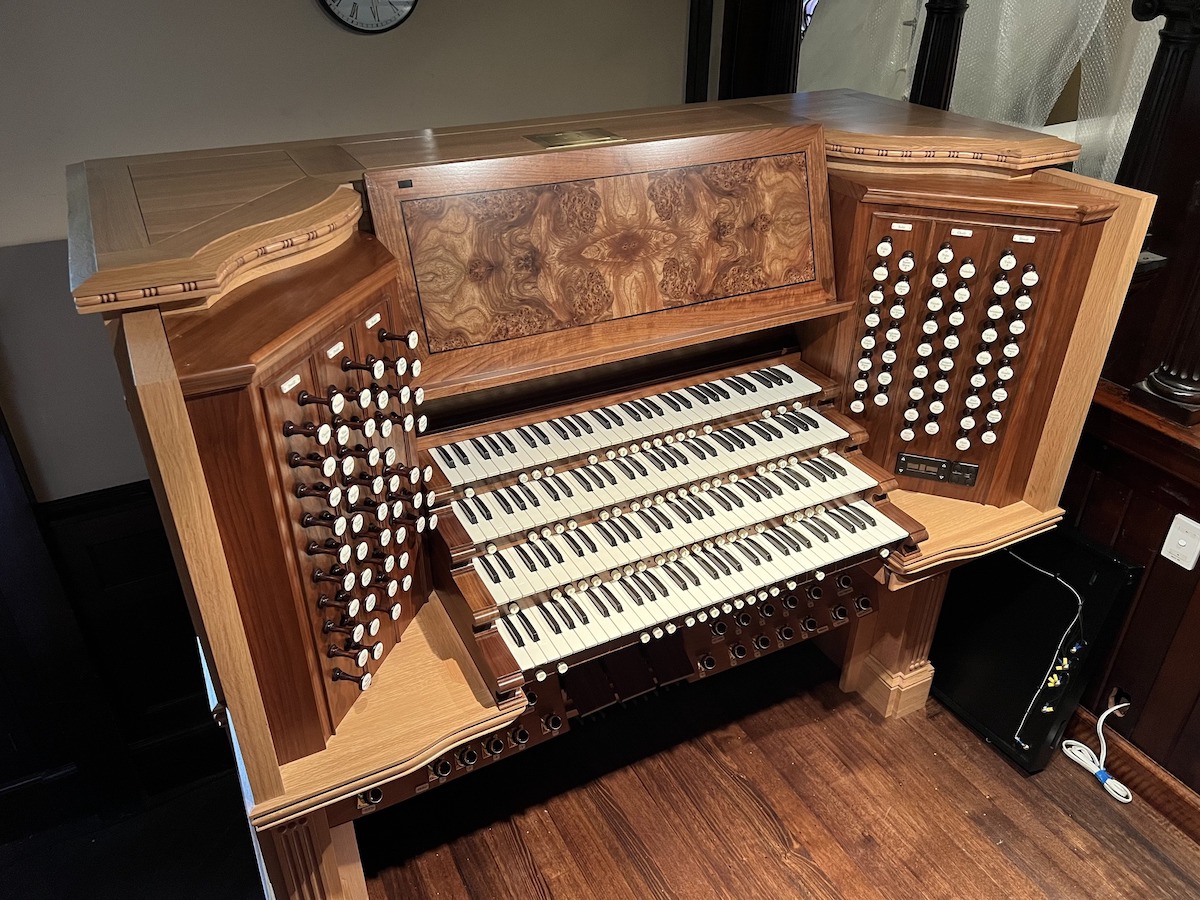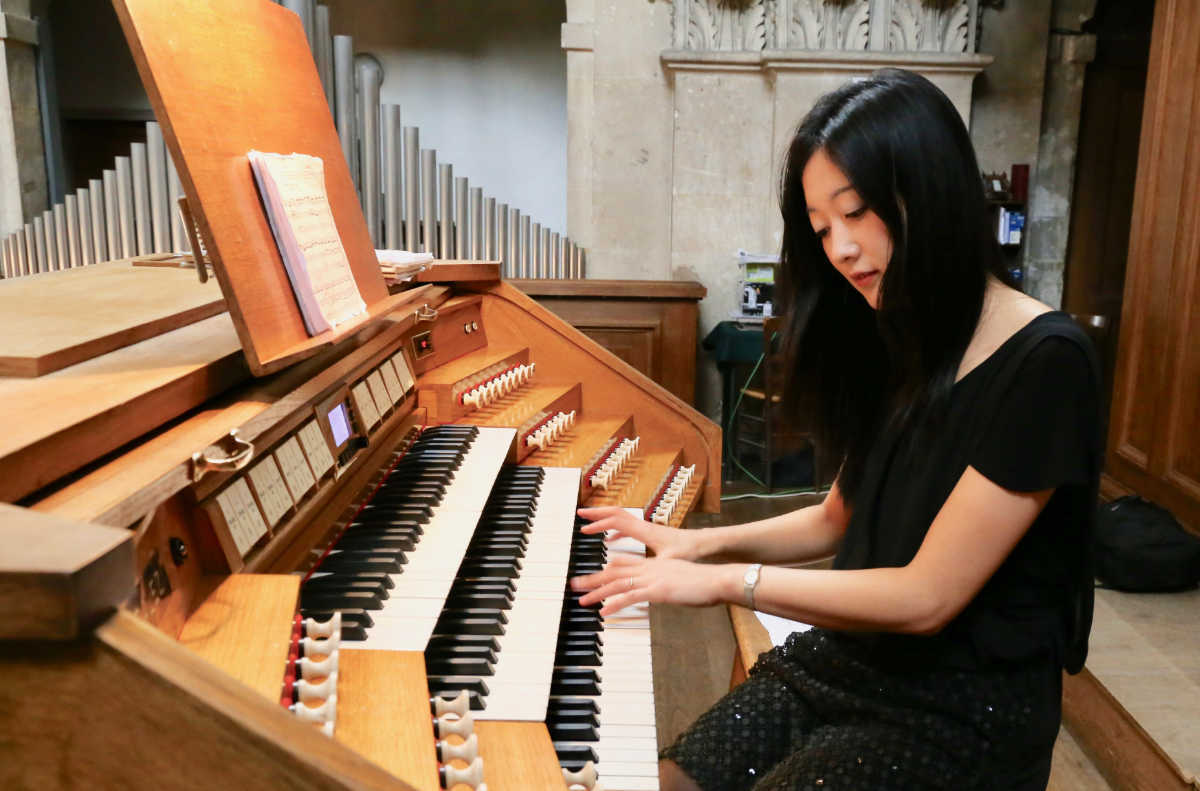Sitting in a pew with a digital keyboard and screen in front of him, US technician John Panning is painstakingly tuning the new organ of St James’ Sydney, pipe by pipe. A colleague of Panning’s, John Streufert, is somewhere in the pipe loft, tapping away with a small hammer.
With more than 3,000 pipes to work through, Panning expects the job to take several weeks.

John Panning’s workstation, St James’ Sydney. Photo supplied
“This whole process is about adjusting the organ so that it sounds right in the acoustic of this building,” he explains. “Every space reflects some frequencies and absorbs others differently, and so we have to listen to each pipe in the space individually and in relation to all the other pipes.”
This is the final stage of the lengthy and, at times, fraught mission to replace the organ of St James’s Church with an instrument worthy of the building. The project to replace the original inhabitant – a venerable instrument, parts of which dated back to 1827 and in the grip of an irreversible decline – was launched in 2017.
In March 2018, it was announced that Dobson Pipe Organ Builders Ltd of Lake City, Iowa, would be responsible for building the new organ in the historic Georgian church. All going to plan, the new instrument would be installed sometime in 2020.
Those plans soon went awry, however.
COVID in the United States severely disrupted the organ builder’s timetable. Worse was to come in June 2021, when the Dobson factory burned to the ground, taking with it all the work done to date on the St James’ organ.
“It was touch and go for a while,” says Panning. “That fire was our worst nightmare come true. There have been some spectacular fire stories in the history of organ building and now we’re one of them. But there was a silver lining. I think it was seen as a proxy for concerns about organ building being in decline, and so lots of people came in to help us rebuild the business. We now have orders stretching into 2028.”

The Dobson #99 during installation in St James’ Sydney
Made from American ash, the Dobson organ (designated #99) is a cutting-edge instrument from a technical perspective, but it still had to fit within the existing architecture of the organ space of St James, and be faithful to the building’s heritage.
“One of the challenges was visual,” says Panning. “Some people really wanted the new woodwork to look exactly like the old and copy the details exactly. But the heritage architects and the authorities were very firm about not making it look like the old woodwork. Now it’s all installed, you can see a clear line of demarcation between the old timbers and the new.”
Unlike the Gothic revival churches built in the same period as St James’ (it was consecrated in 1824), the interior of the Francis Greenaway-designed building features a flat ceiling rather than a vaulted space. Much work also went into strengthening the church’s ceiling above the organ.
“The old ceiling used to vibrate a lot, with all sorts of rattles when the low pipes were sounded,” Panning explains. “That part of the renovation has been a really good thing for us. The flat ceiling gives you a more even surface to bounce the sound off, unlike a vaulted ceiling that can make an organ sound very ‘live’ and very loud in one spot but not another.”
When everything has been tuned and the instrument bedded in, St James’ will boast one of the best organs in the country, says organist Marko Sever, St James’ Assistant Head of Music. As he speaks, he opens a small drawer in the organ’s console: in it, a digital touch pad. “I don’t know exactly how this works yet,” Sever admits, “but I’m told you can record yourself on it and have the organ play it straight back.”
There’s also a signed plaque engraved with every one of the organ’s builders. “A lovely touch, Dobsons does that on all its instruments,” Sever says. “I think anyone who gets to play this will enjoy it immensely. It rewards the player as much as it does the listener.”

The console of the Dobson #99 awaiting installation.
Once the tuning and bedding in is complete, the new organ’s capabilities will be showcased in St James’ International Organ Festival, commencing late July and running until mid-November.
The first concert (26 July) will be given by the leading English organist James O’Donnell, currently Professor of Organ and Sacred Music at Yale University.
A former Master of Music at Westminster Cathedral in London, his 1998 recording of masses by Frank Martin and Ildebrando Pizzetti won him a Gramophone Record of the Year Award. In 2000, O’Donnell was appointed Organist and Master of the Choristers at Westminster Abbey where he was responsible for the music at all services, including many significant national and state occasions, among which are the wedding of Prince William and Catherine Middleton, and the state funerals of Queen Elizabeth the Queen Mother and, most recently, that of Her late Majesty Queen Elizabeth II.
Marko Sever takes to the console on 3 August, having recently spent six years working and studying in London, gaining experience in the English Cathedral tradition with two years at Westminster Cathedral, where he regularly accompanied and directed the famed Cathedral Choir. While at the Cathedral, he recorded his debut CD, Symphonie-Passion, on its world-famous Grand Organ.
On 1 September, four former organists of St James’ will reunite in a celebratory “first hurrah”.
Mirroring the old organ’s farewell “Last Hurrah” concert in October 2022, Daniel Dries, David Drury, Peter Jewkes and Andrej Kouznetsov will showcase works by Bach, Franck and Mulet, with kaleidoscopic improvisations by Drury woven throughout the program.

Sarah Kim. Photo @ Dimitri Scapolan
The festival concludes on 16 November with a recital by one of the instrument’s rising starts, Sarah Kim. Born in Germany, schooled in Australia and now based in Paris, Kim has performed with numerous ensembles including the Sydney Symphony Orchestra, the Australian Youth Orchestra and the Sydney Children’s Choir, and as a soloist in major concert venues including the Sydney, Perth and Melbourne Town Halls and the Sydney Opera House.
With the new organ in place, St James’ will be ready to reclaim its place in the musical and social life of Sydney, says Reverend Christopher Waterhouse, Rector of St James’.
“We all know that church attendances are declining and it’s part of my job as Rector to rise to that challenge and think about not just new ways this wonderful place can bring in new people, but also how it can become more involved in the cultural life of the city.”
Historically, Waterhouse says, the Church has always been a patron across the whole spectrum of the arts.
“That’s what I’d like to see here. This has to be more than just a nice new organ for Sunday morning worship. We have to make the best of this opportunity and invite as many people as possible to play it. My dream would be that any day of the week, you’ll be able to step inside St James’ and hear someone playing, rehearsing or teaching a student. I see the making of music as part of the church’s civic responsibility.”
“St James’ has a musical heritage that goes back to the early days of the Colony and now we have an instrument in it that is truly world-class. We’re already part of a big cultural precinct here and it’s time for St James’ to put itself back on the map.”
St James’ International Organ Festival runs from 26 July – 16 November.












Comments
Log in to join the conversation.